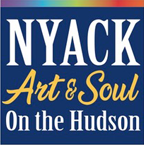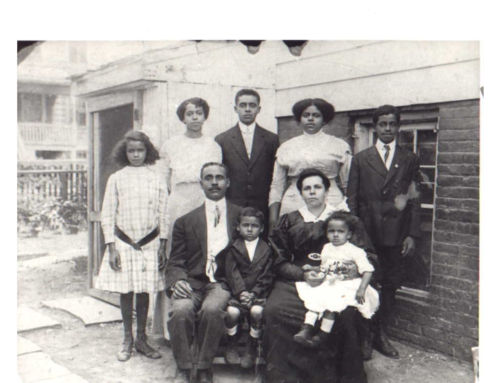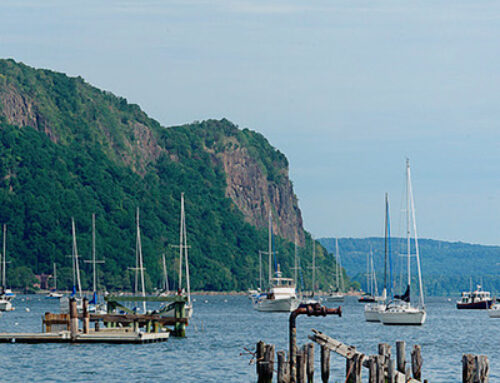by Gini Stolldorf, Newsletter Editor, Historical Society of the Nyacks
Posted here with permission. Click here to read the original.
The source of the Hudson River is Lake Tear of the Clouds in the Adirondack Mountains. As the river flows south and reaches the Nyack area it flows in two directions. The Lenapes who lived in the area called this body of water “Muhheakantuck” to describe its dual direction. In the 1600s, when the Dutch started to settle here, they referred to it as the “north river,” acknowledging the search for a Northwest Passage and the exploration of Henry Hudson in 1609. As Hudson sailed north out of New Amsterdam (New York City) in search of this passage, the river widened to approximately three miles across. Some thought that Hudson’s ship, the Half Moon, had entered a sea, so the river in this area became known as the “Zee” (Dutch for sea). By 1664, the English had settled in this region and justified their takeover by promoting Hudson’s English heritage and the fact that he was “just sailing” for the Dutch East India Company.
During the 1700s, overland travel was the way to go. By the 1800s, however, waterways became the important means of transportation, commercially and recreationally, due to advances in technology. In New York State, when the Erie Canal opened in 1825, the Great Lakes became connected to the Atlantic Ocean by way of Albany and the Hudson River, which became a connection burgeoning with traffic. As the 19th century progressed, Nyack became home to many boatyards and ferry landings.
In 1880, James Smith of Smith’s Boatyard received a contract to build a large flat-bottomed boat with square ends, known as a scow. This vessel, built for Denton Fowler at a cost of $5,000, was 100-feet long and 35-feet wide, and would subsequently be used to transport bricks from the brickyards of Haverstraw to New York City.
In 1883, John P. Voris, whose boatyard was in Upper Nyack, was rebuilding the steamer called Pleasant Valley. They were also building a large three-deck excursion barge that was capable of transporting many people up and down the Hudson. In the spring of 1893, Samuel Ayers purchased the boatyard from Voris. Ayers, from Brooklyn, had owned a steam-yacht business there for over 40 years and later brought his entire yacht-building business to Upper Nyack. He built yachts for, among others, the Vanderbilts and the Morgans. In 1896, John Jacob Astor commissioned Ayers to build one of the first and largest yachts with electricity. It was 72-feet long and had three engines, all run by electricity. The cabins were built of mahogany and bronze and featured leather seats. The main salon, with fold-out tables and built-in seats upholstered in velvet and trimmed in gold, covered the entire width of the yacht. The owner’s state room was seven feet long and appointed similarly to the main salon.
Also in the 1890s, at the Charles L. Seabury & Co. shipyard in Nyack, a large number of yachts and launches were under construction, many of which were over 72-feet long and equipped with staterooms, folding sofa-beds, and toilet rooms. Most could accommodate over 20 people.
Along with the building of vessels for water travel came ideas for inventions to improve water travel. In 1877, Eli Hunt of Nyack came up with an idea for the propulsion of vessels up to 30 miles per hour, which would help to increase their steadiness in the water. In 1882, Theodore F. Odell, also interested in the propulsion of watercraft, patented a devise to enhance the propelling of vessels more economically. Abraham G. Polhemus’s inventions helped protect steamboats against the dangers of fire.
Quarries
Not only was the Hudson River key in the transportation of bricks from Haverstraw to New York City, the river also transported stone from the quarries on the Palisades cliffs.
This semi-molten, igneous rock, dating back over 30 million years (Triassic period), was forced up through a fissure in the earth’s crust. Over eons, as the earth’s crust continued to shift and erode, a “flint-hard diabase” was exposed to form a 30-mile- long cliff face on the west side of the Hudson River. By the end of the 1800s, this cliff face, as noted by Giovanni da Verrazano and Henry Hudson, was being blasted away.
Many quarries littered the 30-mile shore. The quarrymen found that the Palisade stone ground up easily and mixed well with cement. Also, since the stone abutted the river, the labor involved to load it onto barges was diminished. The sound of the blasting could be heard at all hours during the day. Finally, a group of women, members of the Englewood Women’s Club, focused their attention on the destruction of the Palisades.
They started writing letters to every newspaper in New York State, accepted invitations to speak before interested groups, and started to lobby legislators. Due to their movement to SAVE THE PALISADES, New Jersey and New York governors, Foster M. Voorhees and Theodore Roosevelt, agreed that preserving the Palisades would benefit both states. In 1901, the Palisades Interstate Park Commission was founded. The quarry at Hook Mountain in Upper Nyack was one of the last quarries finally put out of business by the Commission. In 1917, after many years of litigation, the PIP succeeded in having the face of the quarry, from the river’s edge to the top, condemned for park purposes at the highest price ever paid by the Commission. One of the quarry’s owners was Wilson P. Foss of Upper Nyack.
Ferries and Steamboats
As early as the 1700s, there were ferry services on the Hudson River. Around 1729, William Dobbs, a farmer living in Van Cortlandt Manor, decided to supplement his income by taking travelers across the river. He hollowed out a flat-bottomed log that he propelled with oars. Dobbs called his vessel a periauger and he would go back and forth to Sneden’s Landing. Molly Sneden started operating a ferry herself and during the Revolutionary War took both British and Colonial troops across the river. William Dobbs’s son, Jeremiah, took over the family business and continued to run it until 1759 when the family sold it. The ferry site, Dobbs Ferry, and the community that developed around it, continues today. By the mid-19th century, Tarrytown developed a ferry service across the Hudson to Nyack. These two communities, across the river from each other, are located where the river broadens and flows a bit slower to New York Harbor and the Atlantic. All of these communities were growing and the ferries became the link for their merchants and farmers.
A noted steamboat, the Chrystenah was built in William Dickey’s Nyack boatyard in 1865-66. The name came from the owners who wanted to honor their mother, Chrystenah Smith. Her portrait graced the main salon of the steamboat during its 60 years of service, which ended in the 1920s. And though ferries began to accommodate automobiles, transportation was changing and the boats started to disappear. The opening of the George Washington Bridge in 1931 had a profound impact on river traffic.
The Hudson River Valley still commands interest. It has often been compared to the Rhine River Valley in Europe. In 1998, the Hudson was designated an American Heritage River by the U.S. Environmental Protection Agency (EPA). Recently, National Geographic Traveler magazine named the Hudson River Valley one of its top 20 destinations in the world!



